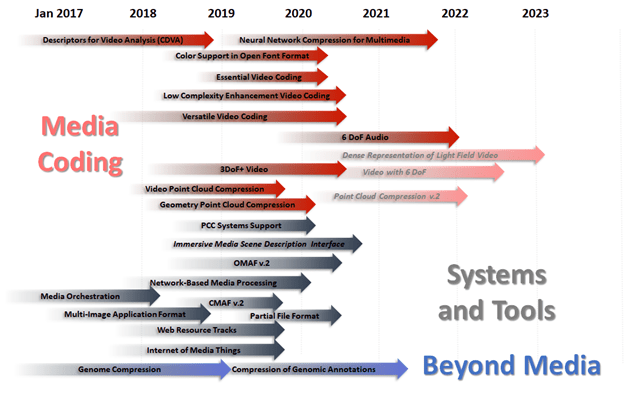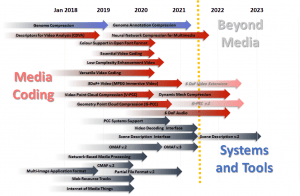Introduction
In Life inside MPEG I introduced the MPEG work plan. The clock in MPEG moves fast and that work plan is now obsolete. Here is a new re-formatted version of the MPEG work plan as of March 2019.
The MPEG work plan at a glance
Figure 1 shows the main standards that MPEG has developed or is developing in the 2017-2023 period. The figure is organised in 3 main sections:
- Media Coding (e.g. AAC and AVC)
- Systems and Tools (e.g. MPEG-2 TS and File Format)
- Beyond Media (currently Genome Compression).\

Figure 1 – The MPEG work plan (March 2019)
Disclaimer: dates in the figure and in the following are all planned.
Navigating the areas of the MPEG work plan
The 1st column in Figure 2 gives the currently active MPEG standardisation areas. The first row gives the currently active MPEG standards. The non-empty white cells give the number of “deliverables” (Standards, Amendments and Technical Reports) currently identified in the work plan.

Figure 2 – Standards (S), Amendments (A) and Technical Reports (T) in the MPEG work plan (as of March 2019)
Video coding
In the Video coding area MPEG is currently developing specifications for 4 standards: MPEG-H, -I, -5 and -CICP) and is conducting explorations in advanced technologies for immersive visual experiences.
MPEG-H
Part 2 – High Efficiency Video Coding 4th edition specifies a profile of HEVC that will have an encoding of a single (i.e. monochrome) colour plane and will be restricted to a maximum of 10 bits per sample, as done in past HEVC range extensions profiles, and additional Supplemental Enhancement Information (SEI) messages, e.g. fisheye video, SEI manifest, and SEI prefix messages.
MPEG-I
Part 3 – Versatile Video Coding, currently being developed jointly with VCEG, MPEG is working on the new video compression standard after HEVC. VVC is expected to reach FDIS stage in July 2020 for the core compression engine. Other parts, such as high level syntax and SEI messages will follow later.
MPEG-CICP
Part 4 – Usage of video signal type code points 2nd edition will document additional combinations of commonly used code points and baseband signalling.
MPEG-5
This standard is still awaiting approval, but MPEG has already obtained all technologies necessary to develop standards with the intended functionalities and performance from the Calls for Proposals (CfP).
- Part 1 – Essential Video Coding will specify a video codec with two layers: layer 1 significantly improves over AVC but performs significantly less than HEVC and layer 2 significantly improves over HEVC but performs significantly less than VVC.
- Part 2 – Low Complexity Video Coding Enhancements will specify a data stream structure defined by two component streams: stream 1 is decodable by a hardware decoder, stream 2 can be decoded in software with sustainable power consumption. Stream 2 provides new features such as compression capability extension to existing codecs, lower encoding and decoding complexity, for on demand and live streaming applications.
Explorations
MPEG experts are collaborating in the development of support tools, acquisition of test sequences and understanding of technologies required for 6DoF and lightfields.
- Compression of 6DoF visual will enable a user to move more freely than in 3DoF+, eventually, allowing any translation and rotation in space.
- Compression of dense representation of light fields is stimulated by new devices that capture light field with both spatial and angular light information. As the size of data is large and different from traditional images, effective compression schhemes are required.
Audio coding
In the Audio coding area MPEG is working on 2 standards (MPEG-D, and -I).
MPEG-D
In Part 5 – Uncompressed Audio in MP4 File Format, MPEG extends MP4 to enable carriage of uncompressed audio (e.g. PCM). At the moment MP4 only carries compressed audio.
MPEG-I
Part 4 Immersive Audio. As MPEG-H 3D Audio already supports a 3DoF user experience, MPEG-I builds upon it to provide a 6DoF immersive audio experience. A Call for Proposal will be issued in October 2019. Submissions are expected in October 2021 and FDIS stage is expected to be reached in April 2022. Even though this standard will not be about compression, but about metadata as for 3DoF+ Visual, we have kept this activity under Audio Coding.
3D Graphics Coding
In the 3D Graphics Coding area MPEG is developing two parts of MPEG-I.
- Part 5 – Video-based Point Cloud Compression (V-PCC) for which FDIS stage is planned to be reached in October 2019.
- Part 9 – Geometry-based Point Cloud Compression (G-PCC) for which FDIS stage is planned to be reached in January 2020.
The two PCC standards employ different technologies and target different application areas, generally speaking, entertainment and automotive/unmanned aerial vehicles,
Font Coding
In the Font coding area MPEG is working on a new edition of MPEG-4 part 22.
Part 22 – Open Font Format. 4th edition specifies support of complex layouts and additional support for new layout features. FDIS stage will be reached in April 2020.
Genome Coding
In the Genome coding area MPEG has achieved FDIS level for the 3 foundational parts of the MPEG-G standard:
- Part 1 – Transport and Storage of Genomic Information
- Part 2 – Genomic Information Representation
- Part 3 – Genomic information metadata and application programming interfaces (APIs).
In October 2019 MPEG will complete Part 4 – Reference Software and Part 5 – Conformance. In July 2019 MPEG will issue a Call for Proposals for Part 6 – Genomic Annotation Representation.
Neural Network Coding
Compression of this type of data is motivated by the increasing use of neural networks in many applications that require the deployment of a particular trained network instance to a potentially large number of devices, which may have limited processing power and memory.
MPEG has restricted the general field to neural networks trained with media data, e.g. for the object identification and content description, and is therefore developing the standard in MPEG-7 which already contains two standards – CDVS and CDVA – which offer similar functionalities achieved with different technologies (and therefore the standard should be classified under Media description).
MPEG-7
Part 17 – Compression of neural networks for multimedia content description and analysis MPEG is developing a standard that enable compression of artificial neural networks trained with audio and video data. FDIS is expected in January 2021.
Media Description
Media description is the goal of the MPEG-7 standard which contains technologies for describing media, e.g. for the purpose of searching media.
In the Media Description area MPEG has completed Part 15 Compact descriptors for video analysis (CDVA) in October 2018 and is now working on 3DoF+ visual.
MPEG-I
Part 7 – Immersive Media Metadata will specify a set of metadata that enable a decoder to provide a more realistic user experience in OMAF v2. The FDIS is planned for July 2021.
System support
In the System support area MPEG is working on MPEG-4 and -I.
MPEG-4
Part 34 – Registration Authorities aligns the existing MPEG-4 Registration Autorities to current ISO practice.
MPEG-H
In MPEG-H MPEG is working on
Part 10 – MPEG Media Transport FEC Codes. This is being enhanced with the Window-based FEC code. FDAM is expected to be reached in January 2020.
MPEG-I
Part 6 – Immersive Media Metrics specifies the metrics and measurement framework in support of immersive media experiences. FDIS stage is planned to be reached in July 2020.
Transport
In the Transport area MPEG is working on MPEG-2, -4, -B, -H, -DASH, -I and Explorations.
MPEG-2
Part 2 – Systems continues to be a lively area of work 25 years after MPEG-2 Systems reached FDIS. After producing Edition 7, MPEG is working on two amendments to carry two different types of content
- Carriage of JPEG XS in MPEG-2 TS JPEG XS
- Carriage of associated CMAF boxes for audio-visual elementary streams in MPEG-2 TS
MPEG-4
Part 12 – ISO Based Media File Format Systems continues to be a lively area of work 20 years after MP4 File Format reached FDIS. MPEG is working on two amendments
- Corrected audio handling, expected to reach FDAM in July 2019
- Compact movie fragment is expected to reach FDAM stage in January 2020
MPEG-B
In MPEG-B MPEG is working on two new standards
- Part 14 – Partial File Format provides a standard mechanism to store HTTP entities and the partial file in broadcast applications for later cache population. The standard is planned to reach FDIS stage in July 2020.
- Part 15 – Carriage of Web Resources in ISOBMFF will make it possible to enrich audio/video content, as well as audio-only content, with synchronised, animated, interactive web data, including overlays. The standard is planned to reach FDIS stage in January 2020.
MPEG-DASH
In MPEG-DASH MPEG is working on
- Part 1 – Media presentation description and segment formats will see a new edition in July 2019 and will be enhanced with an Amendment on Client event and timed metadata processing. FDAM is planned to be reached in January 2020.
- Part 3 – MPEG-DASH Implementation Guidelines 2nd edition will become TR in July 2019
- Part 5 – Server and network assisted DASH (SAND) will be enriche by an Amendment on Improvements on SAND messages. FDAM to be reached in July 2019.
- Part 7 – Delivery of CMAF content with DASH a Technical Report with guidelines on the use of the most popular delivery schemes for CMAF content using DASH. TR is planned to be reached in March 2019
- Part 8 – Session based DASH operation will reach FDIS in July 2020.
MPEG-I
Part 2 – Omnidirectional Media Format (OMAF) released in October 2017 is the first standard format for delivery of omnidirectional content. With OMAF 2nd Edition Interactivity support for OMAF, planned to reach FDIS in July 2020, MPEG is extending OMAF with 3DoF+ functionalities.
Application Formats
MPEG-A ISO/IEC 23000 Multimedia Application Formats is a suite of standards for combinations of MPEG and other standards (only if there are no suitable MPEG standard for the purpose). MPEG is working on
Part 19 – Common Media Application Format 2nd edition with support of new formats
Application Programming Interfaces
The Application Programming Interfaces area comprises standards that make possible effective use of some MPEG standards.
MPEG-I
Part 8 – Network-based Media Processing (NBMP), a framework that will allow users to describe media processing operations to be performed by the network. The standard is expected to reach FDIS stage in January 2020.
Media Systems
Media Systems includes standards or Technical Reports targeting architectures and frameworks.
IoMT
Part 1 – IoMT Architecture, expected to reach FDIS stage in October 2019. The architecture used in this standard is compatible with the IoT architecture developed by JTC 1/SC 41.
Reference Implementation
MPEG is working on the development of standards for reference software of MPEG-4, -7, A, -B, -V, -H, -DASH, -G, -IoMT
Conformance
MPEG is working on the development of standards for conformance of MPEG-4, -7, A, -B, -V, -H, -DASH, -G, -IoMT.
The MPEG standards
MPEG uses acronyms for its standards and industry knows them by them. Here you will find the full list of MPEG standards ordered by the 5-digit ISO numbers.
MPEG-1 ISO/IEC 11172 Coding of moving pictures and associated audio for digital storage media at up to about 1,5 Mbit/s
MPEG-2 ISO/IEC 13818 Generic coding of moving pictures and associated audio information
MPEG-4 ISO/IEC 14496 Coding of audio-visual objects
MPEG-7 ISO/IEC 15938 Multimedia content description interface
MPEG-21 ISO/IEC 21000 Multimedia Framework
MPEG-A ISO/IEC 23000 Multimedia Application Formats
MPEG-B ISO/IEC 23001 MPEG systems technologies
MPEG-C ISO/IEC 23002 MPEG video technologies
MPEG-D ISO/IEC 23003 MPEG audio technologies
MPEG-E ISO/IEC 23004 Multimedia Middleware
MPEG-V ISO/IEC 23005 Media context and control
MPEG-M ISO/IEC 23006 Multimedia service platform technologies
MPEG-U ISO/IEC 23007 Rich media user interfaces
MPEG-H ISO/IEC 23008 High efficiency coding and media delivery in heterogeneous environments
MPEG-DASH ISO/IEC 23009 Dynamic adaptive streaming over HTTP (DASH)
MPEG-I ISO/IEC 23090 Coded representation of immersive media
MPEG-CICP ISO/IEC 23091 Coding-Independent Code-Points
MPEG-G ISO/IEC 23092 Genomic Information Representation
MPEG-IoMT ISO/IEC 23093 Internet of Media Things
MPEG-5 ISO/IEC 23094 General Video Coding
Posts in this thread
- The MPEG work plan (March 2019)
- MPEG and ISO
- Data compression in MPEG
- More video with more features
- Matching technology supply with demand
- What would MPEG be without Systems?
- MPEG: what it did, is doing, will do
- The MPEG drive to immersive visual experiences
- There is more to say about MPEG standards
- Moving intelligence around
- More standards – more successes – more failures
- Thirty years of audio coding and counting
- Is there a logic in MPEG standards?
- Forty years of video coding and counting
- The MPEG ecosystem
- Why is MPEG successful?
- MPEG can also be green
- The life of an MPEG standard
- Genome is digital, and can be compressed
- Compression standards and quality go hand in hand
- Digging deeper in the MPEG work
- MPEG communicates
- How does MPEG actually work?
- Life inside MPEG
- Data Compression Technologies – A FAQ
- It worked twice and will work again
- Compression standards for the data industries
- 30 years of MPEG, and counting?
- The MPEG machine is ready to start (again)
- IP counting or revenue counting?
- Business model based ISO/IEC standards
- Can MPEG overcome its Video “crisis”?
- A crisis, the causes and a solution
- Compression – the technology for the digital age
- On my Charles F. Jenkins Lifetime Achievement Award
- Standards for the present and the future


